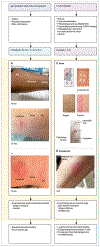Antibiotic allergy
- PMID: 30558872
- PMCID: PMC6563335
- DOI: 10.1016/S0140-6736(18)32218-9
Antibiotic allergy
Abstract
Antibiotics are the commonest cause of life-threatening immune-mediated drug reactions that are considered off-target, including anaphylaxis, and organ-specific and severe cutaneous adverse reactions. However, many antibiotic reactions documented as allergies were unknown or not remembered by the patient, cutaneous reactions unrelated to drug hypersensitivity, drug-infection interactions, or drug intolerances. Although such reactions pose negligible risk to patients, they currently represent a global threat to public health. Antibiotic allergy labels result in displacement of first-line therapies for antibiotic prophylaxis and treatment. A penicillin allergy label, in particular, is associated with increased use of broad-spectrum and non-β-lactam antibiotics, which results in increased adverse events and antibiotic resistance. Most patients labelled as allergic to penicillins are not allergic when appropriately stratified for risk, tested, and re-challenged. Given the public health importance of penicillin allergy, this Review provides a global update on antibiotic allergy epidemiology, classification, mechanisms, and management.
Copyright © 2019 Elsevier Ltd. All rights reserved.
Conflict of interest statement
Declaration of interests
The authors declare no competing interests. KGB receives research funding and career development support from the National Institutes of Health, USA and the American Academy of Allergy, Asthma and Immunology Foundation, USA; has authored copy-written material and an electronic decision support tool and app used institutionally at Partners Health Care System for hospitalised patients with historical β-lactam allergies; has received royalties from Up To Date (Waltham, MA, USA) and honorarium from the New England Society of Allergy, USA. JGP is supported by a grant from the National Institutes of Health, USA (K43 TW011178-01). JAT is supported by a National Health and Medical Research Council (NHMRC) of Australia Early Careers Fellowship and a post-doctoral scholarship from the National Centre for Infections in Cancer (NCIC, Australia). EJP reports grants from NHMRC of Australia; grants from the National Institute of Health, USA (1P50GM11530501, 1P30AI110527-01A1, R21AI139021, and R34AI136815); grants from the Australian Centre for HIV and Hepatitis Virology Research (all paid to the institution); personal fees from Up To Date and Biocryst; consulting fees not directly received from Aicuris, outside the submitted work; and is co-director of IIID Pty Ltd that holds patent for HLA-B*57:01 testing for abacavir hypersensitivity, without any financial remuneration and not directly related to the submitted work. Funders played no role in any aspect of this Review.
Figures





References
-
- Duong TA, Valeyrie-Allanore L, Wolkenstein P, Chosidow O. Severe cutaneous adverse reactions to drugs. Lancet 2017; 390: 1996–2011. - PubMed
-
- Garon SL, Pavlos RK, White KD, Brown NJ, Stone CA Jr, Phillips EJ. Pharmacogenomics of off-target adverse drug reactions.Br J Clin Pharmacol 2017; 83: 1896–911. - PMC - PubMed
Publication types
MeSH terms
Substances
Grants and funding
LinkOut - more resources
Full Text Sources
Medical

